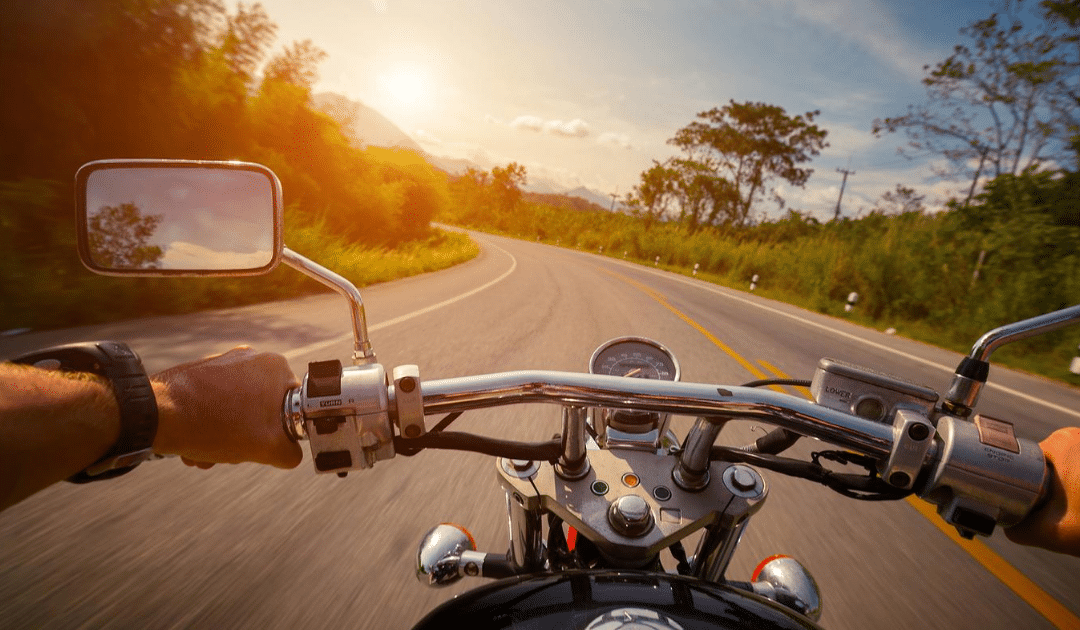Late summer riding beckons; open roads, open skies, long days, and beautiful sunsets. The flipside? Extreme heat. And also a transition period of reacquainting yourself with the roads and traffic. Use these tips to keep your bike and yourself cool and safe.
For Your Bike
Keeping your ride cool and running smoothly through the summer usually entails a little extra maintenance. Here are some of the priority areas to fitness-check before setting out.
- Tires – Tire blowouts are usually caused by underinflated, rather than overinflated, tires. Make sure to inflate to the manufacturer’s recommended PSI. And remember that high external temps cause tire pressure to increase due to expanding gas. Check them each week and adjust as necessary. Also keep an eye on the tires’ condition, looking for any cracks, punctures, bulges, or worn tread.
- Fluids – Check oil, brake, coolant, hydraulic fluids, and their reservoirs for debris, condensation, and discoloration or changed consistency. Get them changed if they’re due. Check the water pump and hoses regularly for leaks, cracks, and tears. Pro tip: cover your radiator to keep the engine cool (and protect it from dirt, bugs and UV rays). On the hottest days, avoid stationary idling to prevent engine overheating.
- Gas tank – If your bike has been sitting all winter with fuel in the tank, it might not start up. Drain the tank — if there’s any brown grit in the fuel, your tank has probably rusted. You can take it to a mechanic or DIY by flushing with acid remover. After cleaning, treat the new gasoline with a fuel stabilizer.
- Electrical connections – If your electrical connections aren’t secure, the moisture from humid environments can short the connection and stop your bike from functioning. Inspect all wires and connections to components (including battery) and fasten any loose ones. If they’re corroded, it’s best to replace them.
For You
Riding in extreme heat can increase your chance of health risks, overheating, and accident risk. Follow these tips to stay safe and comfortable.
- Hydration – Staying hydrated is one of the best preventive measures for summer riding. Drink water at every stop and consider purchasing a CamelBak for extended rides. Avoid alcohol, as it can easily dehydrate you.
- Sun safety – Even if it’s overcast, you’re still getting hit by UV rays. Wear sunscreen and reapply to exposed skin as often as possible.
- Clothing – Safe riding means extra layers, even in the summer heat. Here are some hacks to keep you cool in your gear.
- Form-fitting sportswear can keep your body temperature down – look for moisture-wicking fabric.
- A lightweight base layer under your jacket and pants can prevent discomfort and keep you dry.
- When leather pants are too hot, check out specialized jeans that have Kevlar fabric lining and other safety components. Never wear shorts.
- Opt for ventilated summer-weight boots, which allow airflow to cool the feet and ankles.
- Mesh-backed gloves will let you grip the handles while allowing for ventilation – as well as hand protection in case of a fall or skid.
- There are options for jackets that protect while keeping you comfortable in the heat. Ventilated jackets with mesh panels allow for aeration, and many perforated leather jackets come with zip vents, which help you release body heat.
- A proper helmet – required by law in all but 3 states – is safety rule number one. Investing in a breathable, lightweight and ventilated helmet will keep your head (and by extension, your body) cool and protected. The best ones are usually carbon fiber.
Get Re-Accustomed to the Road
If you’ve been traveling mostly by car and are just getting back to the roads on 2 wheels, give yourself some time to re-adjust. You no longer have the wrap-around metal protection of a vehicle, and you may need to fine-tune your reaction time for sharing the road with cars.
Most motorcycle accidents are attributed to unsafe lane changes, car doors, speeding, sudden stops, left-turn accidents, and lane splitting, among others, so make sure you’re visible to the cars around you.
Finally, know the signs of heat stress (check out our article here). It can come on suddenly, so knowledge and prevention are your tools to stay cool and healthy.
This article is furnished by California Casualty, providing auto and home insurance to educators, law enforcement officers, firefighters, and nurses. Get a quote at 1.866.704.8614 or www.calcas.com.
- Graduation – When to Remove Your Child from Your Auto Policy - May 18, 2023
- How to Prevent Catalytic Converter Theft - May 17, 2023
- How Much Does Home Insurance Cost? - May 17, 2023

